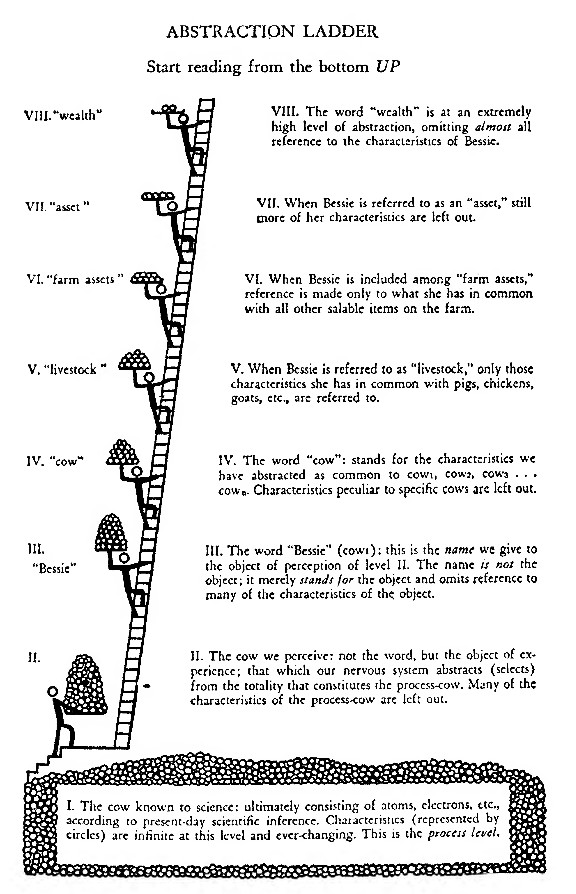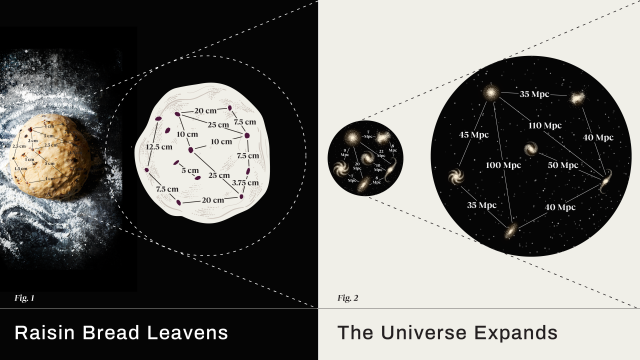Boost your communication skills with the “ladder of abstraction”

- Sometimes we can talk or write ad nauseam yet still not get our point across.
- The “ladder of abstraction” reveals why people communicating about the same thing may be doing so at different levels.
- By considering our ideas from both the abstract and concrete levels, we not only get our idea across more clearly, we also learn more about our own thinking.
Imagine you’re listening to a renowned academic give a presentation on … something. But after an hour-long onslaught of textbook terms, obscure jargon, and soggy statements, you have the vague sense that nothing meaningful was actually said.
Then there’s this one: You’re chatting with a friend over coffee about his new business venture. Your second cup is dry, and he is still droning on about sales charts, overhead costs, shipping logistics, and whatever the hell a “360-degree solution” is. By the time you finally excuse yourself to the bathroom, you’re left wondering what the point was.
The details may vary, but you’ve definitely endured something similar: someone trying to share an idea with you but leaving you with little more than a mental blank space to be filled in later. (Maybe?)
A reason for this all-too-common experience is what psychologists call “the curse of knowledge.” The curse is actually a cognitive bias, or a systematic error in our thinking. In this case, a communicator mistakenly, and often unconsciously, believes that everyone in the conversation shares the same knowledge, understandings, and experiences they do. The result is that they skip over the vital information others will need to comprehend their message.
The curse of knowledge is why laypeople find scientific studies tangled, students find geometric proofs baffling, and everyone finds instruction manuals tortuously frustrating. The researchers, teachers, and technical writers had difficulty imagining what it was like to not know what they knew and so communicated their ideas ineffectually.
Nor does the idea have to be complicated to fall prey to the curse. Everyone is susceptible. Thankfully, there is a mental tool that can help us break the curse: the “ladder of abstraction”

Laws of abstraction
First proposed by the semanticist, and one-time Senator, Samuel I. Hayakawa, the ladder of abstraction is, obviously, a rather abstract concept. To help explain it in his 1939 book, Language in Action, Hayakawa employed the aid of Bessie the cow.
Bessie is a beaut of a bovine and has many characteristics that make her unique from all other cows. When we speak or write of her, we are discussing an individual cow with those characteristics. This makes the name Bessie the most concrete way we can refer to her with words and so we place Bessie on the bottom rung of the ladder of abstraction.
For every rung we move up the ladder, the words we can use to describe Bessie leave out more and more of those Bessie-ful details. That is, they become more and more abstract.
One rung higher is the word cow, which includes only those characteristics Bessie shares with other female cattle. One rung above that is cattle, which mixes her in with bulls, heifers, and bullocks. A rung above that is livestock, which references only the characteristics Bessie shares with pigs, chickens, goats, and so on. Going up, we have farm asset and asset. Eventually, we’ll reach the super abstract concepts of value and wealth.
Speakers and writers can move up and down the ladder of abstraction to describe most any idea. Another example, this time moving down the ladder:
- Aesthetics.
- Art.
- Impressionism.
- An Impressionist painting.
- Claude Monet’s Sunrise.
Additionally, the ladder may lead you to different places depending on the idea being communicated. Hayakawa’s top-level abstraction for Bessie was wealth, but this abstraction looks at our best girl from the point of view of an economist. If the speaker is a biologist, their top-level abstraction may be organism. For an animal rights activist, it may be conscious being.

Climbing the ladder of abstraction
At this point, it’s fair to ask how the ladder of abstraction can help you convey ideas more effectively. After all, your next presentation likely won’t be on 50 ways to present a cow.
Hayakawa explains:
“The reason we must concern ourselves with the process of abstracting is that the study of language is all too often regarded as being a matter of examining such things as pronunciation, spelling, vocabulary, grammar, and sentence structure. […] But as we know from everyday experience, learning language is not simply a matter of learning words; it is a matter of correctly relating our words to the things and happenings for which they stand.”
Hayakawa’s point is that words often contain more ambiguity than we typically account for. Their effect extends beyond their dictionary definition. They also evoke feelings, imply meanings, and suggest nuances that shift based on the identities, histories, expertise, and personalities of the user and recipient alike.
Consider, for instance, the abstract phrases we bandy about in political discussions — things like liberty, free enterprise, and social justice. Each sounds agreeable when viewed from the ladder’s tippy-top rungs. But as Hayakawa points out, scuttle down to the bottom rungs, and you’ll find that people can have wildly different opinions on the concrete details. The words they use may be the same, but their meanings are not.
“Definitions, contrary to popular opinions, tell us nothing about things. They only describe people’s linguistic habits,” Hayakawa argues.
The ladder of abstraction illustrates another problem with conveying ideas clearly: “dead-level abstracting.” This is Hayakawa’s phrase for when someone communicates almost exclusively at one level on the ladder.
Perched on the ladder’s top rungs, an economist may lecture on the labor force through high-level classifications, macroeconomic terminology, and phrases like “enunciatory modalities” (say what?). But unless he connects those ideas with the real jobs that people commute to and experience everyday, his meaning will be lost on listeners who don’t think like him.
“The trouble with speakers who never leave the higher levels of abstraction is not only that they fail to notice when they are saying something and when they are not; they also produce a similar lack of discrimination in their audiences,” Hayakawa writes.
Communicators who stick to the low-rung details don’t fare much better. A science journalist may write beautifully about a newly discovered fossil. But unless she ties those details and facts together into a handy generalization or purposeful takeaway about evolutionary history, then she’ll leave her readers wondering, “So what?”

Breaking the curse of knowledge
It may seem then that the ladder of abstraction’s solution to breaking the curse of knowledge is a Goldilocks one. If we stick to the middle rungs, we can strike a perfect balance between abstractions and concrete details. But that’s not quite right.
According to Hayakawa clear communication, “as well as clear thinking,” involves a “constant interplay of higher and lower level abstractions.” In other words, by traveling up and down the ladder, we reveal the meaning behind the details and vice versa.
A brilliant example of such rhetorical balance comes from Jared Diamond’s Pulitzer Prize-winning Guns, Germs, and Steel: “We all know that history has proceeded very differently for peoples from different parts of the globe. In the 13,000 years since the end of the last Ice Age, some parts of the world developed literate industrial societies with metal tools, other parts developed only nonliterate farming societies, and still others retained societies of hunter-gatherers with stone tools.”
Notice how Diamond starts with abstract concepts like history and different peoples. These concepts seem simple enough, but to clarify his meaning, he takes a few steps down the ladder. To history, he adds the characterization of “the 13,000 years since the end of the last Ice Age.” Different peoples is elaborated on to include “literate industrial societies,” “nonliterate farming societies,” and “hunter-gatherers.”
The rest of Diamond’s introduction to his book continues in this vein. He uses concrete details to show how more abstract concepts connect to the real world; meanwhile, the abstract gives meaning to the facts and details.
Studying accomplished writers, presenters, and orators is one way to learn to navigate the ladder of abstraction. Other strategies will depend on your personal style.
- If you’re the kind of communicator who enjoys ideas from a bird’s eye view, try asking yourself “how” questions. These will often lead to the data, examples, and stories needed to clarify your meaning.
- If you prefer your feet on the ground, try asking “why” questions. These help you discover the patterns, lessons, and generalizations that tie your facts together.
Of course, there will always be people who won’t connect with your ideas, no matter how well you articulate them. That’s the risk of any act of communication. But by considering our ideas from all levels of the ladder of abstraction, we not only learn how to help our audience understand them. We learn more about them ourselves.






